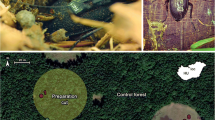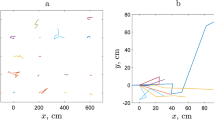Summary
The individual movements of four carabid species were investigated by tracing beetles in the field using a portable radar system (harmonic radar). The field-inhabiting a Pterostichus melanarius Illiger, P. niger Schaller and Harpalus rufipes De Geer were traced in cereal fields. The movements of P. melanarius Mnd P. niger were also tracked in a wood and then compared with the movements of the forest-species Carabus nemoralis Müller. P. melanarius and P. niger displayed directed movements in cereal fields, although P. niger moved faster than P. melanarius. The movement pattern of H. rufipes in the field, and C. nemoralis and P. malanarius in the wood can be described as a c correlated random walk. In cereal fields, P. melanarius burrowed actively into the soil, and P. niger searched out crevices. In contrast, none of these two carabids burrowed in the forest soil, whereas C. nemoralis did. No statistically significant difference was observed between the movements of hungry and satiated beetles, although starved beetles tended to disperse shorter distances per move and turned back more often (especially P. niger). The significance of the various movement patterns exhibited by the species studied for their reproduction and survival on arable land is discussed.
Similar content being viewed by others
References
Baars MA (1979) Patterns of movement of radioactive Carabid beetles. Oecologia (Berlin) 44:125–140
Boer PJ den ((1977) Dispersal power and survival. Carabids in a cultivated countryside. Misc Papers Landbouwhogesch Wageningn 14:1–190
Boer PJ den (1982) On the stability of animal populations, or how to survive in a heterogeneous and changable world? In: Mossakowski D, Roth G (eds) Environmental adaptation and evolution. Fischer, Stuttgart, pp 211–232
Cain ML (1988) Movement pattern analysis: Statistical evaluation of correlated random walk models. Ecology (in press)
Chiverton PA (1987a) Predation on Rhopalosiphum padi (Hom: Aphididae) by polyphagous predatory arthropods during the aphids' pre-peak period in spring barley. Ann Appl Biol 111:257–269
Chiverton PA (1987b) Predation on the bird-cherry oat aphid in cereals. Plant Protection Reports, Dissertation 11, Uppsala, 32+87 pp
Evans MEG, Forsythe TG (1984) A comparison of adaptation to running, pushing and burrowing in some adult Coleoptera: especially Carabidae. J Zool 202:513–534
Forsythe TG (1984) Feeding mechanisms of certain ground beetles (Coleoptera: Carabidae). Coleopt Bull 36:26–73
Grüm L (1971) Spatial differentiation of the Carabus L. (Carabidae, Col.) mobility. Ekol Pol 19:1–34
Kareiva PM, Shigesada N (1983) Analyzing insect movement as a correlated random walk. Oecologia (Berlin) 56:234–238
Lenski RE (1984) Food limitation and competition. A field experiment with Carabus species. J Anim Ecol 53:203–216
Lindroth CH (1945) Die Fennoskandischen Carabidae. I. Göteborgs Kungl Vetensk Vitterh-Samh. Handl (B4 (1), Gothenburg
Luff M (1980) The biology of the ground beetle Harpalus rufipes in a strawberry field in Northumerland. Ann Appl Biol 94:153–164
Mascanzoni D, Wallin H (1986) The harmonic radar: a new method of tracing insects in the field. Ecol Entomol 11:387–390
Sota T (1985) Activity patterns, diets and interspecific interactions of coexisting spring and autumn breeding carabids: Carabus yaconinus and Leptocarbabus kumagaii (Coleoptera, Carabidae). Ecol Entomol 10:315–324
Southwood TRE (1978) Ecological Methods. Chapman & Hall, London
Speight MR, Lawton JH (1976) The influence of weed-cover on the mortality imposed on artificial prey by predatory ground beetles in cereal fields. Oecologia (Berlin) 23:211–223
Sunderland KD (1975) The diet of some predatory arthropods in cereal crops. J Appl Ecol 12:507–515
Thiele HU (1977) Carabid beetles in their environments. Zoophysiol Ecol 10, Springer, Berlin Heidelberg, New York
Wallin H (1985) Spatial and temporal distribution of some abundant carabid beetles (Coleoptera: Carabidae) in cereal fields and adjacent habitats. Pedobiologia 28:19–34
Wallin H (1986) Habitat choice of some field-inhabiting carabid beetles (Coleoptera: Carabidae) studied by recapture of marked individuals. Ecol Entomol 11:457–466
Wallin H (1987) Distribution, movements and reproduction of carabid beetles (Coleoptera: Carabidae) inhabiting cereal fields. Plant Protection Reports, Dissertations 15, Uppsala, 25+109 pp
Author information
Authors and Affiliations
Rights and permissions
About this article
Cite this article
Wallin, H., Ekbom, B.S. Movements of carabid beetles (Coleoptera: Carabidae) inhabiting cereal fields: a field tracing study. Oecologia 77, 39–43 (1988). https://doi.org/10.1007/BF00380922
Received:
Issue Date:
DOI: https://doi.org/10.1007/BF00380922




